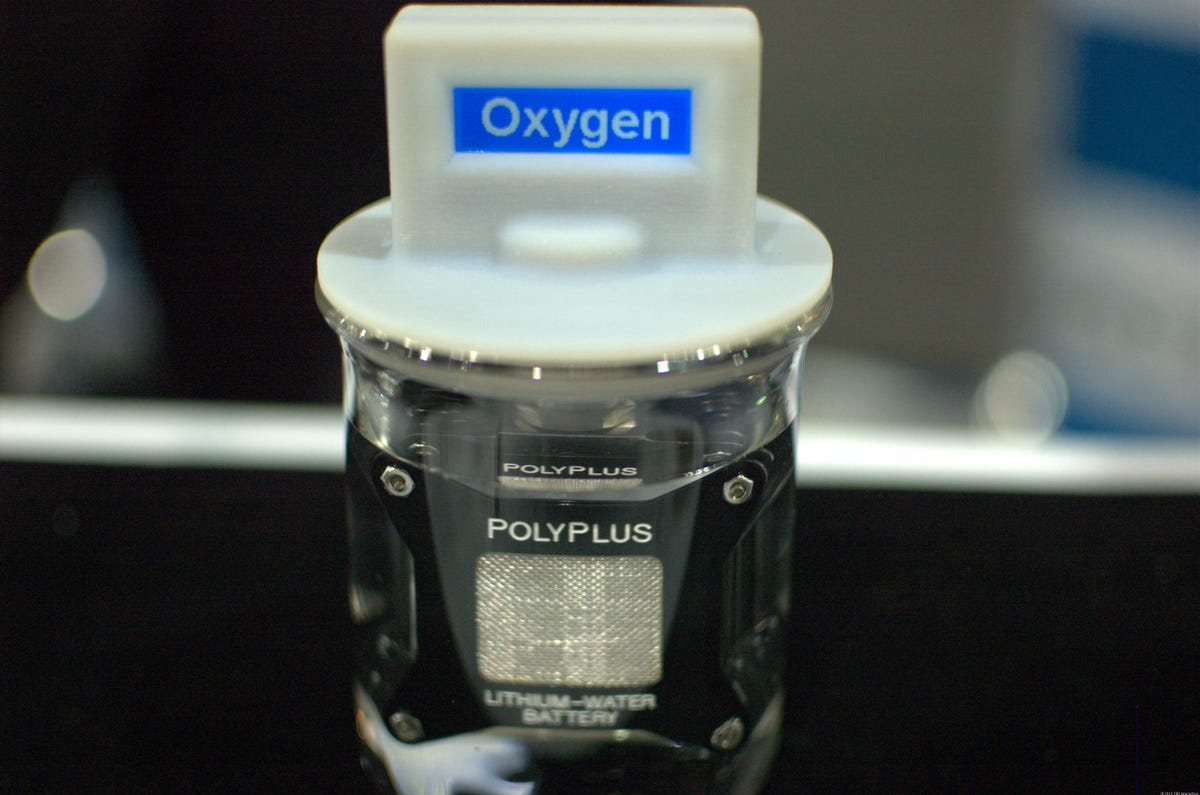Reinventing energy at ARPA-E (photos)
At the ARPA-E Energy Innovation Summit, startups and research organizations show off the latest inventions in the multiple paths to cleaner energy.

Blow others out of the water
PolyPlus Technology is developing lithium air and lithium water batteries that promise a big jump in the storage capacity of lithium ion batteries. The company has developed a material that will allow batteries to operate using the dissolved oxygen in water or the air, which its says is key to making energy-dense lithium air batteries viable. The company's plan is to start making lithium water batteries for underwater uses, such as robots, in two years. Then it intends to make a lithium air battery one year later, and perhaps three to five years from now, a rechargeable lithium air battery.
Mini heliostats
Commercial R&D company Otherlab is showing off a completely new approach to heliostats, the sun-tracking mirrors used to concentrate sunlight to generate electricity. Rather than large and expensive steel trackers, the company has designed these water-filled plastic trackers. By changing the flow of the water in the three "legs" of the tracker, a central control unit can change the pressure inside and redirect the mirrors to face the sun. The idea is that several of these smaller units could be placed on a steel plate flat on the ground, which Otherlab expects to be cheaper.
Plastic light concentrator
The ARPA-E Energy Innovation Summit brings a number of startups but a large portion of the exhibitors are from national labs, universities, and research organization. PARC, which is a Xerox company, has an energy research arm and is displaying this solar concentrator. It reflects light with dies in a sheet of plastic and then directs it up through the Fresnel lens on the top. The idea is to manufacture this at very small scale so that you could use sheets of plastic with this design embedded in it to reflect light cheaply.
Ready for takeoff
Makani Power is making a machine to capture the fast wind at high altitudes. The company has already run tests of this flying wing which generates electricity as it spins around a tethered cable.
Efficient power electronics
EnPhase is one of the companies that received a grant to improve the power electronics in the grid, a seemingly obscure but important issue. The company has developed a chip (black box at right) made on a gallium arsenide substrate which is part of the electronics needed to switch from alternating current on the grid to direct power that many machines, such as motors, use. The goal is to handle much higher voltages on the grid and to reduce the losses that occur when switching from AC to DC and back.
Daylight-sensitive LED fixture
In the area of energy efficient lighting, Digital Lumens showed off this LED light fixture which is equipped with a daylight sensor (on the top). When it detects light, it gradually turns down the brightness of the LED light sources, a way to save energy while maintaining consistent light levels.
Microbial fuel cell
One technology which continues to attract research is microbial fuel cells, where the growth of microorganisms creates a flow of electricity. In this project led by the University of Massachusetts, researchers are seeking to find stable organisms which can produce desired chemicals, such as butanol, more efficiently than previously done.
Evolvulator 1.0
Shown here is the testing equipment used by Harvard University's Wyss Institute to produce a reverse microbial fuel cell, which would use electricity and carbon dioxide to produce a biofuel. The machine which shakes the flask, called a turbidostat, is used to grow certain organisms and locate organisms which are good candidates for further study. Because it's a competition to survive, the Harvard researchers have nicknamed the machine the Evolvulator 1.0.
Solar hydrogen generator
Nanoptek CEO John Guerra (left) shows the company's device to produce hydrogen with the aid of solar cells. The company intends to sell the hydrogen generators to industrial companies which now purchase tanks of hydrogen.
Glass energy storage
Startup Halotechnics is developing materials that can be used to store energy from concentrating solar power plants. It's starting with molten salt chemistries that can improve over existing molten salt storage methods. For the longer term, it's developing glass-based liquid storage, according to CEO and founder Justin Raade, who is holding samples of the glass storage medium.
Shape memory alloys
Walking through the showcase at the ARPA-E Energy Innovation Summit is a clear reminder on the close connection between energy and materials. Here General Motors is showing off research on shape memory alloys, a type of metal that will heat up when stretched and vice versa. The long-term plan of this research is take the waste heat from car engines and convert that into a motion to generate electricity. In the shorter term, it expects to use the material as a low-power replacement for actuators and motors in simple latches.
Efficiency and horsepower booster
During his keynote address, Energy Secretary Steven Chu called out the work being done by Umpqua Energy on improving fuel efficiency. In front is a catalytic converter and the device behind it is a cold plasma reformer designed to improve fuel efficiency and boost the power of vehicles. The reformer can take hydrocarbon fuel and convert some of it to hydrogen, which is then reinjected into the engine. In an actual car, it would be about the size of the catalytic converter and be bolted onto the side of engine.
Making hydrogen from the sun
SunCatalytix is a start-up spun out of MIT to build an inexpensive device called an electrolyzer for getting hydrogen fuel from water by running an electric current through it. It received funding from ARPA-E to build a prototype (seen here) of a material that will make hydrogen directly from a solar cell. The hydrogen would then be stored and used as a fuel to generate electricity.

